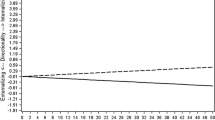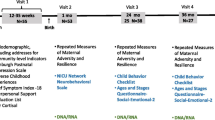Abstract
Prior research indicates that closely spaced births are associated with poor outcomes for the mother and subsequent child. Limited research has focused on outcomes for the index child (the child born immediately prior to a subsequent child in a birth interval). The objectives are to assess the association of short birth intervals in at-risk families with: (1) indicators of harsh and neglectful parenting behaviors towards the index child, including substantiated maltreatment reports across 6 years; and (2) the index child’s behavior and development in first grade. This is a longitudinal study of 658 women screened to be at-risk for child maltreatment. Twenty percent of women had a rapid repeat birth (RRB), defined as the birth of a subsequent child within 24 months of the index child. Generalized estimating equations, survival analyses, and linear and logistic regression models were used to assess the associations between RRB and index child outcomes. Women with an RRB were more likely than those without an RRB to report neglectful parenting of the index child. Children of mothers with an RRB were more likely than children of mothers without an RRB to have more behavioral problems and lower cognitive functioning in first grade. This study is among the first to focus on the associations of birth spacing with maltreatment, behavior and development outcomes in the index child. Future work regarding the effects of birth spacing should include a focus on the index child.

Similar content being viewed by others
References
Healthy People 2010. (2000). 9-2. Reduce the proportion of births occuring within 24 months of a previous birth. US Department of Health and Human Services. Available from http://www.healthypeople.gov/2010/document/html/objectives/09-02.htm.
Healthy People 2020. (2010). FP-5. Reduce the proportion of pregnancies conceived within 18 months of a previous birth. US Department of Health and Human Services. Available from http://www.healthypeople.gov/2020/topicsobjectives2020/objectiveslist.aspx?topicid=13.
King, J. C. (2003). The risk of maternal nutritional depletion and poor outcomes increases in early or closely spaced pregnancies. Journal of Nutrition, 133(5 Suppl 2), 1732S–1736S.
Conde-Agudelo, A., Rosas-Bermudez, A., & Kafury-Goeta, A. C. (2007). Effects of birth spacing on maternal health: a systematic review. American Journal of Obstetrics and Gynecology, 196(4), 297–308.
Klerman, L. V., Cliver, S. P., & Goldenberg, R. L. (1998). The impact of short interpregnancy intervals on pregnancy outcomes in a low-income population. American Journal of Public Health, 88(8), 1182–1185.
Polit, D. F., & Kahn, J. R. (1986). Early subsequent pregnancy among economically disadvantaged teenage mothers. American Journal of Public Health, 76(2), 167–171.
Conde-Agudelo, A., Rosas-Bermudez, A., & Kafury-Goeta, A. C. (2006). Birth spacing and risk of adverse perinatal outcomes: a meta-analysis. JAMA, 295(15), 1809–1823.
Zhu, B. P. (2005). Effect of interpregnancy interval on birth outcomes: findings from three recent US studies. International Federation of Gynecology and Obstetrics, 89(Suppl 1), S25–S33.
Zhu, B. P., Haines, K. M., Le, T., McGrath-Miller, K., & Boulton, M. L. (2001). Effect of the interval between pregnancies on perinatal outcomes among white and black women. American Journal of Obstetrics and Gynecology, 185(6), 1403–1410.
Zhu, B. P., & Le, T. (2003). Effect of interpregnancy interval on infant low birth weight: a retrospective cohort study using the Michigan Maternally Linked Birth Database. Maternal and Child Health Journal, 7(3), 169–178.
Zhu, B. P., Rolfs, R. T., Nangle, B. E., & Horan, J. M. (1999). Effect of the interval between pregnancies on perinatal outcomes. New England Journal of Medicine, 340(8), 589–594.
Benedict, M. I., White, R. B., & Cornely, D. A. (1985). Maternal perinatal risk factors and child abuse. Child Abuse and Neglect, 9(2), 217–224.
Zuravin, S. J. (1988). Fertility patterns: Their relationshp to child physical abuse and child neglect. Journal of Marriage and the Family, 50, 983.
Zuravin, S. J., & DiBlasio, F. A. (1996). The correlates of child physical abuse and neglect by adolescent mothers. Journal of Family Violence, 11(2), 149–166.
Hayes, H., Luchok, K., Martin, A. B., McKeown, R. E., & Evans, A. (2006). Short birth intervals and the risk of school unreadiness among a Medicaid population in South Carolina. Child: Care, Health and Development, 32(4), 423–430.
Cheslack-Postava, K., Liu, K., & Bearman, P. S. (2011). Closely spaced pregnancies are associated with increased odds of autism in California sibling births. Pediatrics, 127, 246–253.
Powell, B., & Steelman, L. C. (1993). The educational benefits of being spaced out: Sibship density and educational progress. American Sociological Review, 58(3), 367.
El-Kamary, S. S., Higman, S. M., Fuddy, L., McFarlane, E., Sia, C., & Duggan, A. K. (2004). Hawaii’s healthy start home visiting program: Determinants and impact of rapid repeat birth. Pediatrics, 114(3), e317–e326.
Duggan, A., Windham, A., McFarlane, E., Fuddy, L., Rohde, C., Buchbinder, S., et al. (2000). Hawaii’s healthy start program of home visiting for at-risk families: Evaluation of family identification, family engagement and service delivery. Pediatrics, 105((1, Part 3)), 250–259.
Duggan, A. K., McFarlane, E., Fuddy, L., Burrell, L., Higman, S. M., Windham, A., et al. (2004). Randomized trial of a statewide home visiting program to prevent child abuse: Impact in preventing child abuse and neglect. Child Abuse and Neglect, 28, 597–622.
Kempe, H. (1976). Child abuse and neglect: The family and the community. Cambridge, MA: Ballinger.
Abidin, R. R. (1986). Parenting stress index—Manual (PSI). Charlottesville, VA: Pediatric Psychology Press.
Straus, M. A. (1995). Manual for the conflict tactics scales (CTS) and test forms for the revised conflict tactics scale (CTS2). Durham, NH: University of New Hampshire Family Research Laboratory.
Straus, M. A., Hamby, S. L., Finkelhor, D., Moore, D. W., & Runyan, D. (1998). Identification of child maltreatment with the parent-child conflict tactics scales. Development and psychometric data for a national sample of American parents. Child Abuse and Neglect, 22(4), 249–270.
Achenbach, T. M., & Rescorla, L. A. (2001). Manual for the ASEBA school-age forms & profiles. Burlington, VT: University of Vermont, Research Center for Children, Youth & Families.
Sparrow, S. S., Balla, D., & Cicchetti, D. V. (1984). Vineland adaptive behavior scales. Circle Pines, MN: American Guidance Service, Inc.
Wiig, E. H., Secord, W., & Semel, E. (1992). Clinical evaluation of language fundamentals. San Antonio, TX: Psychological Corporation.
Thorndike, R. L., Hagen, E. P., & Sattler, J. M. (1986). Stanford-Binet Intelligence Scale (4th ed.). Itasca, IL: Riverside Publishing.
McHorney, C., & Ware, J. (1995). Construction and validation of an alternate form general mental health scale for the medical outcomes study short-form 36-item health survey. Medical Care, 33, 15–28.
Straus, M. A. (1979). Measuring intra-family conflict and violence: The conflict tactics (CT) scales. Journal of Marriage and the Family, 41, 75–88.
Mayfield, D., McLeod, G., & Hall, P. (1974). The CAGE questionnaire: Validation of a new alcoholism screening instrument. American Journal of Psychiatry, 131, 1121–1123.
Zeger, S. L., & Liang, K.-Y. (1986). Longitudinal data analysis for discrete and continuous outcomes. Biometrics, 42, 121–130.
Duggan, A. K., McFarlane, E. C., Windham, A. M., Rohde, C. A., Salkever, D. S., Fuddy, L., et al. (1999). Evaluation of Hawaii’s healthy start program. The Future of Children, 9(1), 66–90.
Child Maltreatment. (2009). U.S.Department of Health and Human Services, Administration for Children and Families, Administration on Children,Youth and Families, Children’s Bureau. Available from http://www.acf.hhs.gov/programs/cb/stats_research/index.htm#can.
Gibbs, E. D., Teti, D. M., & Bond, L. A. (1987). Infant-sibling communication: Relationships to birth-spacing and cognitive and linguistic development. Infant Behavior and Development, 10, 307–323.
Bella, H., & Al-Almaie, S. M. (2005). Do children born before and after adequate birth intervals do better at school? Journal of Tropical Pediatrics, 51(5), 265–270.
Lopez, L. M., Hiller, J. E., & Grimes, D. A. (2010). Postpartum education for contraception: A systematic review. Obstetrical and Gynecologival Survey, 65(5), 325–331.
Yeakey, M. P., Muntifering, C. J., Ramachandran, D. V., Myint, Y., Creanga, A. A., & Tsui, A. O. (2009). How contraceptive use affects birth intervals: Results of a literature review. Studies in Family Planning, 40(3), 205–214.
Centers for Disease Control, Prevention. (2010). U S. Medical Eligibility Criteria for Contraceptive Use. MMWR Recommendations and Reports, 59(RR-4), 1–6.
Olds, D. L., Eckenrode, J., Henderson, C. R., Jr., Kitzman, H., Powers, J., Cole, R., et al. (1997). Long-term effects of home visitation on maternal life course and child abuse and neglect. Fifteen-year follow-up of a randomized trial. JAMA, 278(8), 637–643.
Rubin, D. M., O’Reilly, A. L., Luan, X., Dai, D., Localio, A. R., & Christian, C. W. (2011). Variation in pregnancy outcomes following statewide implementation of a prenatal home visitation program. Archives of Pediatrics and Adolescent Medicine, 165(3), 198–204.
Acknowledgments
This work was supported in part by the National Institute for Mental Health (Grant P30MH38725); the Federal Maternal and Child Health Bureau (Grant R40 MC 00029, formerly Grant MCJ-240637, and Grant R40 MC 00123, formerly Grant MCJ-240838); the Robert Wood Johnson Foundation (Grant 18303); the Annie E. Casey Foundation (Grant 94-4041); the David and Lucile Packard Foundation (Grants 93-6051; 94-7957, 97-8058, and 98-3448) and the Hawaii State Department of Health (Grant 99-29-J). Additional support provided by Agency for Healthcare Research and Quality NRSA Fellowship (Grant T32 HS017596).
Author information
Authors and Affiliations
Corresponding author
Rights and permissions
About this article
Cite this article
Crowne, S.S., Gonsalves, K., Burrell, L. et al. Relationship Between Birth Spacing, Child Maltreatment, and Child Behavior and Development Outcomes Among At-Risk Families. Matern Child Health J 16, 1413–1420 (2012). https://doi.org/10.1007/s10995-011-0909-3
Published:
Issue Date:
DOI: https://doi.org/10.1007/s10995-011-0909-3




